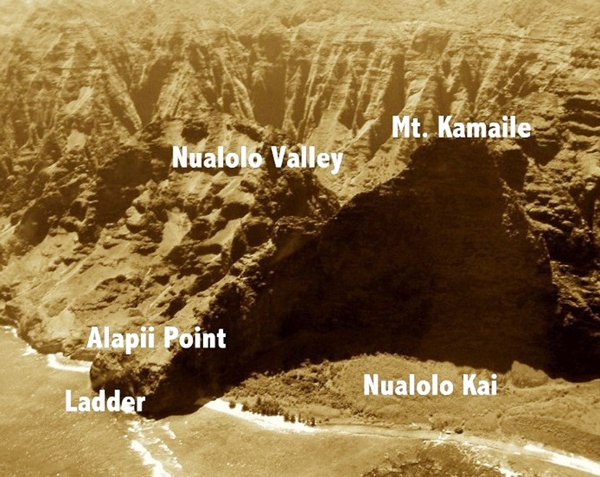For hundreds of years, people traveled between the fishing village at Nualolo Kai on Kaua‘i’s Na Pali Coast and Nualolo Valley, which is situated above and inland of Nualolo Kai and is cut off from Nualolo Kai and the ocean
For hundreds of years, people traveled between the fishing village at Nualolo Kai on Kaua‘i’s Na Pali Coast and Nualolo Valley, which is situated above and inland of Nualolo Kai and is cut off from Nualolo Kai and the ocean by sheer cliffs.
They did so by traversing a steep and narrow cliffside trail, which deteriorated after the village was abandoned in the early 1900s and is now impassable.
But, in the old days, the upward trek to Nualolo Valley from Nualolo Kai began at the base of the approximately 300-foot high Alapi‘i Point on the northeastern boundary of Nualolo Kai.
Following a climb of about 15 feet of perpendicular rock face, there was a 20 to 25 foot tall ladder lashed to the cliff that carried climbers higher.
Honolulu merchant Gorham D. Gilman (1822-1909) wrote of his failed attempt to climb the trail in August, 1845, during a boat trip from Hanalei to Waimea along the Na Pali Coast.
“There I was, my chief support a little projecting stone, not sufficient a hold for my whole foot, and my hands clinging with a death grasp to the rock … which would have proved my death place if I had made the least mistake or slip. I had strong curiosity to go forward, but discretion prevailed and I returned. I was then told that few white men had gone as far as I had, and none had ever passed the ladder.”
Yet, Gilman noted that Hawaiians easily traversed the ladder and the trail.
Fifty years later, in 1895, Kaua‘i kama‘aina Eric Knudsen (1872-1957) climbed the ladder made of two long olopua sticks lashed to the cliff with olona ropes and crawled along a narrow ledge high above the ocean. Hand holds cut into the rocks aided his further ascent to a trail cut in the rock that led up and around the base of the roughly 1,500-foot tall Mount Kamaile and into Nualolo Valley.




Archival photos of the hakalewa o Nuʻalolo can be seen here:
http://www.napali.org/docs/nuk_sourcebook.pdf